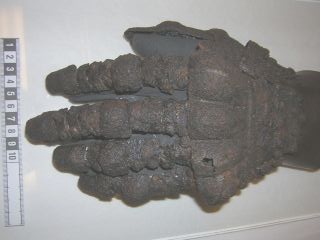
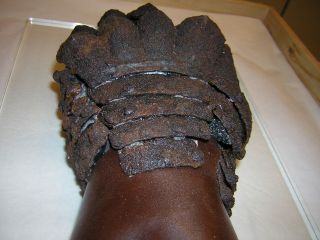
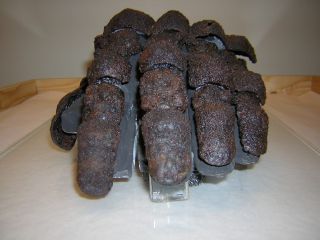
Armor for sale based upon our research
We at Crimson Forge believe that modern armor based upon proven historical designs is superior to what is currently available for personal protection armor, we also believe that historically correct and/or historically based armor is superior to many of the more recently engineered armors which can resemble period designs (or not...) but do not always function in the correct ways. This is usually the result of the craftsman striving to learn how to make a particular pattern, as opposed to striving to "de-engineer" or understand the piece in a contextual manner.
The craftsman at Crimson Forge take our research to the functional level. If you do not use a tool you cannot truly understand a tool. Our research into historical armor would not be complete if we did not produce the armor and evaluate the functionality in as close to real conditions as possible. The survivability of armor is at least as important as the ability to defend against individual attacks. This process also helps to develop an understanding of the repair needs of a design. All of this leads to a better understanding of the forces driving later evolutions and developments of armor.
We are now producing those pieces for the general public as a way of generating the funds necessary to continue our research and development efforts as well as providing the experience of truly functional armor for the modern re-enactor.
Wisby Gauntlet #3 - Status: Full Production
History: The "Battle of Wisby" (usually pronounced in English as "Visby") occurred on July 27th in the year 1361 on the island of Gotland in Sweden. The battle was between the 1800 peasants of the Township of Wisby and the attacking army of King Waldemar of Denmark. More research can be found in the book by Dr. Bengt Thordman "Armor from the Battle of Wisby 1361", My copy was purchased through Chivalry Bookshelf.
Significance: The significance of this particular find is the almost singular nature of its preservation of large numbers of armor and artifacts from the common soldier. This is a very rare glimpse beyond the myths and distortions of movies and misinformation commonly passed on as "facts". The armor found in this excavation sheds light on how far we really had come in the armoring of armies for combat even as it is representative of "outdated" armor. Indeed if this is an example of "outdated armor" and it is this effective, then what can we surmise from it's ancestors.
Research: I first came across the information about this particular dig while speaking with Brian Price of Chivalry Bookshelves. We had been talking about his upcoming book "Techniques of Medieval Armor Production" and Brian mentioned that he had helped to republish Dr. Thordmans exhaustive work on the Wisby digs from 1926-29 from the island of Gotland, Sweden.
The Wisby #3 gauntlet caught our interest because of it's simple elegance, but when we began to try to reproduce the piece from the photos and narrative provided, the results were less effective than we would have hoped. We found out that the original was in the custody of the Gotland Museum and we composed a letter explaining our research program and provide a list of the questions that we had encountered.
The nice people at the museum replied that we should locate a copy of Dr. Thordmans book for more in-depth study. We replied that we possessed a copy and that our questions could not be answered from the book. They replied that unfortunately they were not in a position to devote the conservator time to discovering the answers at this time but "would a few pictures taken by the Director be of use..... After signing the releases we were sent the following 3 photos for our studies.
(with permission to present them for the first time ever on this site)
(you may click on these pictures to view them in more detail)
Visby gauntlet from Korsbetningen parish of Visby, Gotland, Inv. nr. 19525 Photo: Annica Ewing/The Museum of National Antiquities
The condition of the piece had obviously degraded since their excavation (techniques being what they were at the time) however the shape when viewed from these new angles was staggering to say the least. All of my work on the metacarpal region was in error. As we had already begun to discover, when there is a lack of functionality in a period piece, one should always start with the parts that are not exactly like the original. In this case the top down views previously presented gave no indication of the depth of the structure.
We were was so incorrect that we immediately wrote back explaining the discovery. We included photos of our previous works and explained that if we were that wrong about the metacarpal region, that we were probably just as wrong in regards to the thumb and thumb root construction. We also requested any new photos of the inside.
We were rewarded with the following two shots of the thumb structure and the extra two shots of plate #27, one inside one outside, which happened to fall off during the movement. Our research would not have been as successful as it was without their gracious assistance.
(you may click on these pictures to view them in more detail)
Photograph Visby gauntlet from Korsbetningen parish of Visby, Gotland, Inv. nr. 19525 Photo: Annica Ewing/The Museum of National Antiquities
Some of the information that our research has yielded so far:
1. Some of the plates were on the inside of a covering material, some were on the outside.
The position of the rivets and the orientation of the pieces in-situ were such that the only way that they could be mounted was under the covering.
For the plates to be on the outside of the construction they would have to have been facing the other direction.
2. The plates that were on the outside were specifically chosen.
We wondered how they chose these specific plates to be exposed.
If the purpose was protection of the valuable iron plates from the elements why not cover them all?
We noticed that on traditional leather "duello" gloves the areas of the glove that were showing the most wear
are the areas that the Wisby #3 had external plating.
3. The separation and angle between the thumb root and metacarpal plate is very specific.
The position of the separation provides the first portion of the thumb articulation.
The angle of the separation is such that it matches the muscle separation below it.
4. The sequence of plate construction yields a lateral transmission of force.
The plates on the outside of the covering transmit to the covering, then to the finger scales.
The separation of the plates is such that the shock continues to be dampened and moved laterally until dissipated.
5. The foundation glove, the shock padding layer, and the mounting layer must be harmonious to work properly.
We have three patterns available for glove construction.
Modified modern gloves to have the period concept applied.
Later period pattern which work best but use a design only documented later.
Period gloves based upon the St. Hadelin pair dated to prior to the Wisby find.
We have two padding options.
Period style wool padding in a linen shell. 1/4" - 5/16" thickness - This is standard on all Leather, Steel, 1050 Gauntlets
Modern Sorbothane padding. - 7.5 times as effective as closed cell foam - This is standard on all Titanium Gauntlets
The mounting leather is specifically chosen for its toughness and longevity.
Artwork showing some of the Wisby #3's construction detail
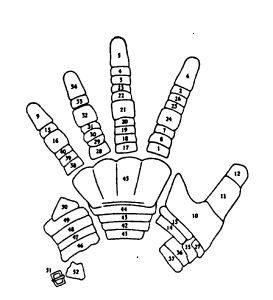
This is a copy of the plate layout proposed by Dr. Thordman

This is a colorized version showing external (grey) and Internal (brown) plates mounted to a black leather base

An artist concept drawing of the Traditional gauntlet
The following photos show some of our current production models
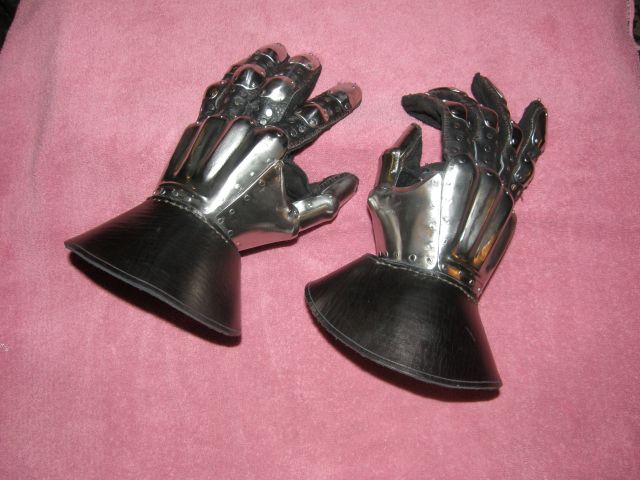
Wisby #3 - Simplified Pattern - Wide Cuff w/No Armor
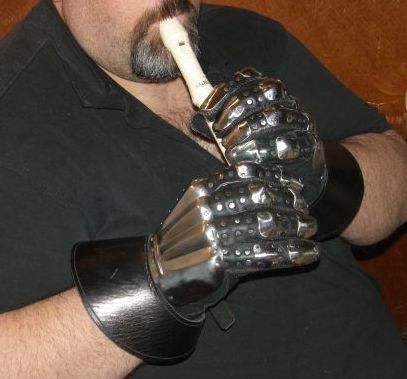
No longer a choice between protection and mobility
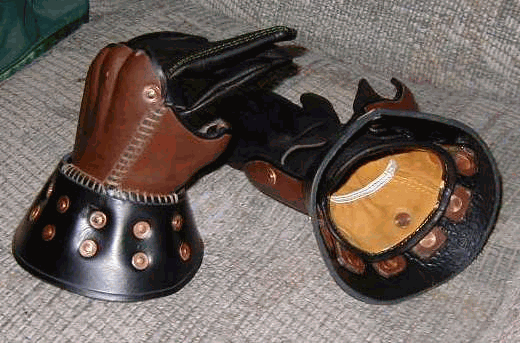
Wisby #3 - Demi - Simplified Pattern - Wax Hardened Leather
Wisby #3 -Demi - Traditional Pattern - 1050 Tool Steel Prior to hardening
Wisby #3 -Either Pattern - Fingers Prior to assembly to base leather
CRIMSONFORGE is currently NOT accepting orders
We hope to be caught up on past orders and taking new orders by the end of the year!